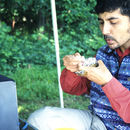en
names in breadcrumbs


A medium-sized (8 inches) thrush, the Wood Thrush is most easily identified by its brown back, rusty-red head, and heavily spotted breast. Other field marks include pinkish legs, short tail, and thick, slightly curved bill. Male and female Wood Thrushes are similar to one another in all seasons. The Wood Thrush breeds across the eastern United States and southern Canada from New Brunswick and Nova Scotia south to northern Florida and west to North Dakota. In winter, this species migrates south to southern Mexico and Central America. Like many bird species wintering in the American tropics, the Wood Thrush crosses the Gulf of Mexico twice a year while on migration. Wood Thrushes primarily breed in deciduous forests with a tall canopy and open forest floor. In winter, this species inhabits humid tropical forests. Wood Thrushes mainly eat insects and other invertebrates during the breeding season, but may also eat fruits and berries during the winter. In appropriate habitat, it may be possible to see Wood Thrushes hopping along the forest floor while foraging for insect prey. More often, however, Wood Thrushes are identified by their song, an unmistakable series of flute-like notes repeated with numerous embellishments and alterations. Wood Thrushes are primarily active during the day, but, like many migratory songbirds, this species migrates at night.